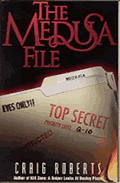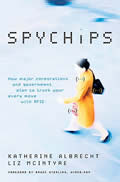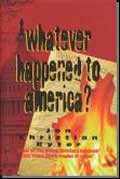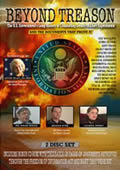Other
Ryter
Articles:
The Two Kerry's:
War Hero or
Traitor?
"Men in Black" The Cult of The Judges
GOSPEL
OF JUDAS: AUTHENTIC FRAUD
By Jon Christian Ryter
April 9, 2006
NewsWithViews.com
The publishing rights of the recently found "lost" gospel of Judas Iscariot�which was converted into a made-for-TV spectacular on Sunday, April 9 on the National Geographic Channel�was secured by the National Geographic Society for a contribution to the manuscript's owner�the Maecenas Foundation for Ancient Art�purported to be more than $1 million to date. (The money was contributed by Gateway Computer founder Ted Waitt.) The Society has now embarked on a concerted effort to mainstream the apocryphal 3rd, 4th or 5th century AD papyrus manuscript as the legitimate diary of Judas Iscariot. The Gospel of Judas suggests that Judas was instructed by Christ to betray Him to the Sanhedrin so that His death would fulfill the Old Testament Messianic prophecies.
The Society plans several magazine articles, television specials and, they said, book deals as the controversy over the ethics of accepting ancient acquisitions on their own merit heats up in the media. Two recently published National Geographic Society books on the Gospel of Judas claim that the papyrus proves that Judas sold Jesus out not as an act of treachery, but obedience. Key passages of the new book were released by the National Geographic Society a week before Easter to build book store sales. With the credibility the National Geographic has around the world, the Gospel of Judas should become an instant best seller.
The only problem with the book�and the papyrus codex from which the content came�is that it was not written by Judas Iscariot nor for that matter, by any of the Apostles or their disciples. While advocates of the authenticity of the gospel as the actual words of Judas Iscariot require a pre-2nd century authorship. The fact that it was written on papyrus doesn't necessarily put it there. In fact, the text translated by the National Geographic Society was written in Sahidic. From a paleographic perspective, that dates the Judas manuscript as 4th or 5th century.
The Coptic Christian Church, which examined the papyrus codex after looters found it in the desert near El Minya, Egypt in the 1970s, said the 62-page codex was written by Christian Gnostics between the 3rd and 4th centuries, AD. A Coptic scholar tapped by National Geographic, Marvin Meyer of Chapman University, said he believed that while the manuscript purchased by the National Geographic Society was probably transcribed in the 3rd or 4th century, the gospel itself was probably originally written prior to the 2nd century. Meyer believed that not from physical evidence, but because he knew that the Synoptic Gospels and all of the Epistles contained within the New Testament were written between 42 AD and 140 AD. But he also knew that codexes were almost nonexistent in the 1st century.
There appears to be only one known first century codex. Only four codexes from 100-199 AD exist today. It was not until the 4th century that bound manuscripts began to replace scrolls in any appreciable numbers and became plentiful relics. By the end of the 5th century, parchment almost universally replaced papyrus for manuscript writing. In Egypt, however, papyrus continued to be the "paper" of choice long after it was abandoned elsewhere. Thus, the fact that the Gospel of Judas was written on papyrus does not "date" the codex as a 1st or 2nd century relic. While advocates of the authenticity of the gospel as a transcription of actual chronologies provided by Judas Iscariot require a pre-2nd century authorship, the fact the it was written on papyrus doesn't necessarily put it there. In point of fact, the text translated by the National Geographic Society was written in Sahidic. From a paleographic perspective, that dates the Judas manuscript as 4th or 5th century. Meyer noted that the anonymous author of the Gospel of Judas was "...obviously a Christian person who was very sympathetic to a Gnostic point of view." (But, let's reserve judgment on the Christian credentials of the author of the codex for a moment.)
The National Geographic Society's panel of scholars subjected the codex to radiocarbon dating, ink analysis and spectral imagining. The experts ruled that the papyrus is an authentic 3rd or 4th century document. That said, it should be noted that this only means the codex came from that era, not that it is a authentic Biblical document. Clearly, it benefits the Society's publishing effort to push its own experts for the earliest possible date since the closer they get to 140 BC the better their argument for authenticity. In point of fact, it is only authentic from the standpoint of antiquity. It is an ancient relic, but its not a missing Gospel from the Bible.
James M. Robinson, professor emeritus at Claremont Graduate University, America's leading expert on ancient religious texts from Egypt, said that while the codex is old, it simply isn't old enough. "Does it go back to Judas? No." Robinson told the Associated Press. "There are a lot of second-, third- and fourth- century gospels attributed to various apostles. We don't really assume they give us any first century information."
In his new book, The Secrets of Judas (Harper-SanFrancisco), Robinson describes the secret maneuvering between Mario Jean Roberty, the Swiss lawyer who founded the Maecenas Foundation for Ancient Art, his client, Frieda Nussberger-Tchakos who bought the codex in 1999 for $300 thousand, Michael van Rijn�an art dealer, confidence man, smuggler, forger and author of an expose on art antiquities, Hot Art, Cold Cash; and two other key players�Ali and Hicham Aboutaam who are the two most notorious cultural heritage thieves in the world. Robinson's book deals with a two decade sales pitch by Roberty�first to buy, and then to sell the content of the Judas manuscript. The asking price was $10 million, but Roberty let it be known that the right buyer could steal it for $3 million.
However, the Maecenas Foundation was not allowed to sell the document under a Swiss law that forbids the sale of illegal antiquities. In other words, the "ownership pedigree"�the legal chain of ownership�of the codex has not been clearly established. Since Roberty cannot legally sell the codex he did the next best thing, he's selling the content. According to Roberty, he bought the codex from Tchakos in 2001 for $1.5 million and 50% the proceeds from the sale of its content. Roberty claims to have already spent more than $1 million on its restoration. Roberty may have found the fund-raisers best scheme and the National Geographic Society has the credibility to give the pseudepigraphic document the aura of authenticity it has thus far lacked.
When Robinson's new book hit the street, the National Geographic Society�not Roberty�responded, saying it was ironic for Robinson to raise so many questions about the authenticity of the codex as the words of Judas Iscariot since "...he tried unsuccessfully to acquire this codex himself." The Society spokesman noted that even though he had never had access to the codex, Robinson nevertheless quoted the text extensively in his book. But the Society spokesman didn't seem to realize the significance of the difference. The difference is Robinson knows that while the codex is an authentic 3rd or 4th century manuscript, it does not represent the spoken or unspoken views, thoughts or statements of Judas Iscariot. The codex was written by Gnostic Christians to dovetail with their theological beliefs.
Gnosticism is the doctrine of salvation through special knowledge. If someone was comparing that 2nd century religion with a contemporary one, gnosticism would be best compared to Scientology. The philosophy of gnosticism was declared heretical by the early Roman church. It is a religion that combines occultism, mysticism, astrology, magic, esoteric Judaism, a modified view Christian perspective of redemption�and Zoroastrianism. Included also are the ancient rituals of Egypt and Mesopotamia that are prevalent in Free Masonry today. The Gnostics beliefs in resurrection and dualism come from Assyrian-Zoroastrian religious ritualism. [Read Jon Ryter's book "Whatever Happened to America?"]
Any well-read Christian who has done any reasonably in-depth analysis of the Pseudepigrapha, the Dead Sea Scrolls or the manuscripts commonly known as the Lost Books of the Bible knows from the text they were not reading the Word of God but that of men attempting to insert their views into the Canon of God. The "Scientology" views of the Gnostics are very clearly depicted in the Gospel of Judas from these sample passages:
"One day he was with his disciples in Judea, and he found them gathered together and seated in pious observation. When he [approached] his disciples [thirty-four] gathered together and seated and offering a prayer of thanksgiving over the bread, [he] laughed. The disciples said to [him], 'Master, why are you laughing at [our] prayer of thanksgiving? We have done what is right.' He answered them and said to them, 'I am not laughing at you. [You] are not doing this because of your own will but because it is through this that your god will be praised.' They said, 'Master, you are [...] the son of our god.' Jesus said to them, 'How do you know me? Truly [I] say to you, no generation of the people that are among you will know me.' When his disciples heard this, they started getting angry and infuriated and began blaspheming against him in their hearts.
When Jesus observed their lack of understanding, he said to them, 'Why has this agitation led you to anger? Your god who is within you and [...] have provoked you to anger [within] your souls. [Let] anyone of you who is [strong enough] among human beings bring out the perfect human and stand before my face.' They all said: 'We have the strength.' But their spirits did not dare to stand before him except for Judas Iscariot. He was able to stand before him, but he could not look him in the eyes, and he turned his face away. Judas said to him, 'I know who you are and where you have come from. You are from the immortal realm of Barbelo."
Under Gnostic cosmology, the Supreme Being�or rather, supreme beings�are two Divine Mothers. The higher deify, Barbelo, is the creative thought of the ineffable parent. The lower deity, Sophia, is the accidental creator of the ignorant demiurge who made the cosmos, but also works to free the divine spirit captured by the demiurge in human form. Barbelo is the First Emanation�the Absolute Being who controls forethought and foreknowledge. According to the Gnostic Apocryphan of John, "...He `thought' His own likeness when He saw it in the pure Light-water that surrounded Him. And His thought [ennoia] became efficacious and made herself manifest. This is the First Thought, His Image. She became the womb of everything for She is prior to them all, the Mother-Father, the First Man [Anthropos], the Holy Spirit, the Thrice-Male, the Thrice-Powerful, the Thrice-named Androgynous One, and the Eternal Aeon among the Invisible Ones, and the first to come forth." Are you reading Canon when you read the Gospel of Judas? I think not. The feminists will love the Gospel of Judas because it gives them a female God.
"Knowing that Judas was reflecting upon something that was exalted, Jesus said to him: 'Step away from the others and I shall tell you the mysteries of the kingdom. It is passable for you to reach it, but you will grieve a great deal. For someone else will replace you in order that the twelve [disciples] may again come to completion with their god....You will become the thirteenth. You will be cursed by the other generations�and you will come to rule over them.' Jesus said, 'Come that I might teach you about secrets no person has ever seen. For there exists a great and boundless realm, whose extent no generation of angels has seen in which there is a great invisible Spirit which no eye of an angel has ever seen, thought of the heart has ever comprehended, and it was never called by any name...A great angel, the enlightened divine Self-Generated, emerged from the cloud. Because of him, for other angels came into being from another cloud, and they became attendants for the angelic Self-Generated."
The "Self-Generated one," of course, is Barbelo, the primary Goddess. Today, she is known as Gaia, or Mother Earth. The first angelic beings, according to the Gospel of Judas, was Adamas, the father of the incorruptible generation of Seth.
"A great angel, the enlightened divine Self-Generated, emerged from the cloud. Because of him, four other angels came into being from another cloud, and they became attendants for the angelic Self-Generated. The Self-Generated said, 'Let [...] come into being [,,,] and it came into being. And he created the first luminary to reign over him. He said, ;Let angels come into being to serve him, and myriads without number came into being. He said let an enlightened aeon come into being, and he came into being. He created the second luminary to reign over him, together with myriads of angels without number, to offer service. That is how he created the rest of the enlightened aeons. He made them reign over them...The multitude of those immortals is called the cosmos�that is, perdition�by the Father of the seven-two luminaries who are with the Self-Generated and his seventy-two aeons. In him the first human appeared with his incorruptible powers.
And the aeon that appeared with his generation, the aeon in whom are the cloud of knowledge and the angel, is called [...] after that [...] said, 'Let twelve angels come into being to rule over chaos and the underworld. And look, from he cloud there appeared an angel whose face flashed with fire and whose appearance was defiled with blood. His name was Nabro, which means rebel. Others call him Yaldabaoth. Another angel, Saklas, also came from the cloud. So Nabro created six angels�as well as Saklas�to be assistants, and these produced twelve angels in the heavens, with each one receiving a portion in the heavens."
Again, in the Gnostic Gospel of Judas, we see a theology that promises to elevate the enlightened to a godlike status�the linchpin found in the theology of every cult in the world. Clearly, from a Scriptural perspective, the Gospel of Judas is heretical. While it is a genuine work of antiquity, it will not provide much of window on early Christianity since it is not a historic snapshot of the world. Nor will it threaten Christian teachings since the serious student of the Bible will quickly recognize it for what it is.
Gnosticism is a philosophical movement that actually predates Christianity although the Gospel of Judas is actually a 4th or even 5th century work. Gnostics believe they have been given secret knowledge about the Supreme Deify, and that they alone possess this special knowledge about humanity and the universe. Like most cults, they believe they alone were provided the insight to understand the true meaning of the message Christ preached. They are convinced that traditional Christianity misinterpreted not only Christ's message, but His mission on Earth as well. Gnostics believe that the Supreme Deify is so remote from human affairs that he-she remains completely undetectable and, thus, unknowable, by human senses. They also believe the Supreme Deity created other finite, yet supernatural, beings called Aeons. One of these Aeons was Sophia�a virgin�who gave birth to a defective, inferior Creator-God.
The Creator God was known as the Demiurge. This lower God is sometimes called Yaldabaoth or Ialdabaoth Jaldabaoth�from Aramaic words meaning "begetter of the Heavens." To the Gnostic, this lower deity is Jehovah�the Hebrew God. He is the Creator of the Earth and all of its life forms. To the Gnostic, Jehovah is fundamentally evil. He is portrayed as jealous, lacking in compassion, and prone to genocide. The Demiurge, according to the Gnostic, thinks he's the Supreme God just as the Gnostic himself, believes when he has the fullness of knowledge, he will attain godhood.
|
Subscribe to the NewsWithViews Daily News Alerts! |
The Coptic Orthodox Church has dismissed the codex as non-Christian babbling resulting from a group of people trying to create a false 'amalgam' between Greek mythology, the Far East religions and Christianity. The codex was written by a group of people who were alien to the main Christian stream of early Christianity. "The texts," Metropolitan Bishoy, the theological leader of the Coptic Orthodox Church. said. "are neither reliable nor accurate Christian texts, as they are historically and logically alien to the main Christian thinking, and philosophy of the early and present Christians."
� 2006 Jon C. Ryter - All Rights
Reserved
[Read Jon Ryter's book "Whatever Happened to America?"]
Sign Up For Free E-Mail Alerts
E-Mails
are used strictly for NWVs alerts, not for sale
Jon Christian Ryter is the pseudonym of a former newspaper reporter with the Parkersburg, WV Sentinel. He authored a syndicated newspaper column, Answers From The Bible, from the mid-1970s until 1985. Answers From The Bible was read weekly in many suburban markets in the United States.
Today, Jon is an advertising executive with the Washington Times. His website, www.jonchristianryter.com has helped him establish a network of mid-to senior-level Washington insiders who now provide him with a steady stream of material for use both in his books and in the investigative reports that are found on his website.
E-Mail: BAFFauthor@aol.com
Again,
in the Gnostic Gospel of Judas, we see a theology that promises to elevate
the enlightened to a godlike status�the linchpin found in the theology
of every cult in the world.













